Jacob Devlin
Gemini 1.5: Unlocking multimodal understanding across millions of tokens of context
Mar 08, 2024Abstract:In this report, we present the latest model of the Gemini family, Gemini 1.5 Pro, a highly compute-efficient multimodal mixture-of-experts model capable of recalling and reasoning over fine-grained information from millions of tokens of context, including multiple long documents and hours of video and audio. Gemini 1.5 Pro achieves near-perfect recall on long-context retrieval tasks across modalities, improves the state-of-the-art in long-document QA, long-video QA and long-context ASR, and matches or surpasses Gemini 1.0 Ultra's state-of-the-art performance across a broad set of benchmarks. Studying the limits of Gemini 1.5 Pro's long-context ability, we find continued improvement in next-token prediction and near-perfect retrieval (>99%) up to at least 10M tokens, a generational leap over existing models such as Claude 2.1 (200k) and GPT-4 Turbo (128k). Finally, we highlight surprising new capabilities of large language models at the frontier; when given a grammar manual for Kalamang, a language with fewer than 200 speakers worldwide, the model learns to translate English to Kalamang at a similar level to a person who learned from the same content.
Gemini: A Family of Highly Capable Multimodal Models
Dec 19, 2023Abstract:This report introduces a new family of multimodal models, Gemini, that exhibit remarkable capabilities across image, audio, video, and text understanding. The Gemini family consists of Ultra, Pro, and Nano sizes, suitable for applications ranging from complex reasoning tasks to on-device memory-constrained use-cases. Evaluation on a broad range of benchmarks shows that our most-capable Gemini Ultra model advances the state of the art in 30 of 32 of these benchmarks - notably being the first model to achieve human-expert performance on the well-studied exam benchmark MMLU, and improving the state of the art in every one of the 20 multimodal benchmarks we examined. We believe that the new capabilities of Gemini models in cross-modal reasoning and language understanding will enable a wide variety of use cases and we discuss our approach toward deploying them responsibly to users.
PaLM 2 Technical Report
May 17, 2023



Abstract:We introduce PaLM 2, a new state-of-the-art language model that has better multilingual and reasoning capabilities and is more compute-efficient than its predecessor PaLM. PaLM 2 is a Transformer-based model trained using a mixture of objectives. Through extensive evaluations on English and multilingual language, and reasoning tasks, we demonstrate that PaLM 2 has significantly improved quality on downstream tasks across different model sizes, while simultaneously exhibiting faster and more efficient inference compared to PaLM. This improved efficiency enables broader deployment while also allowing the model to respond faster, for a more natural pace of interaction. PaLM 2 demonstrates robust reasoning capabilities exemplified by large improvements over PaLM on BIG-Bench and other reasoning tasks. PaLM 2 exhibits stable performance on a suite of responsible AI evaluations, and enables inference-time control over toxicity without additional overhead or impact on other capabilities. Overall, PaLM 2 achieves state-of-the-art performance across a diverse set of tasks and capabilities. When discussing the PaLM 2 family, it is important to distinguish between pre-trained models (of various sizes), fine-tuned variants of these models, and the user-facing products that use these models. In particular, user-facing products typically include additional pre- and post-processing steps. Additionally, the underlying models may evolve over time. Therefore, one should not expect the performance of user-facing products to exactly match the results reported in this report.
QueryForm: A Simple Zero-shot Form Entity Query Framework
Nov 14, 2022Abstract:Zero-shot transfer learning for document understanding is a crucial yet under-investigated scenario to help reduce the high cost involved in annotating document entities. We present a novel query-based framework, QueryForm, that extracts entity values from form-like documents in a zero-shot fashion. QueryForm contains a dual prompting mechanism that composes both the document schema and a specific entity type into a query, which is used to prompt a Transformer model to perform a single entity extraction task. Furthermore, we propose to leverage large-scale query-entity pairs generated from form-like webpages with weak HTML annotations to pre-train QueryForm. By unifying pre-training and fine-tuning into the same query-based framework, QueryForm enables models to learn from structured documents containing various entities and layouts, leading to better generalization to target document types without the need for target-specific training data. QueryForm sets new state-of-the-art average F1 score on both the XFUND (+4.6%~10.1%) and the Payment (+3.2%~9.5%) zero-shot benchmark, with a smaller model size and no additional image input.
Efficiently Scaling Transformer Inference
Nov 09, 2022



Abstract:We study the problem of efficient generative inference for Transformer models, in one of its most challenging settings: large deep models, with tight latency targets and long sequence lengths. Better understanding of the engineering tradeoffs for inference for large Transformer-based models is important as use cases of these models are growing rapidly throughout application areas. We develop a simple analytical model for inference efficiency to select the best multi-dimensional partitioning techniques optimized for TPU v4 slices based on the application requirements. We combine these with a suite of low-level optimizations to achieve a new Pareto frontier on the latency and model FLOPS utilization (MFU) tradeoffs on 500B+ parameter models that outperforms the FasterTransformer suite of benchmarks. We further show that with appropriate partitioning, the lower memory requirements of multiquery attention (i.e. multiple query heads share single key/value head) enables scaling up to 32x larger context lengths. Finally, we achieve a low-batch-size latency of 29ms per token during generation (using int8 weight quantization) and a 76% MFU during large-batch-size processing of input tokens, while supporting a long 2048-token context length on the PaLM 540B parameter model.
Scaling Instruction-Finetuned Language Models
Oct 20, 2022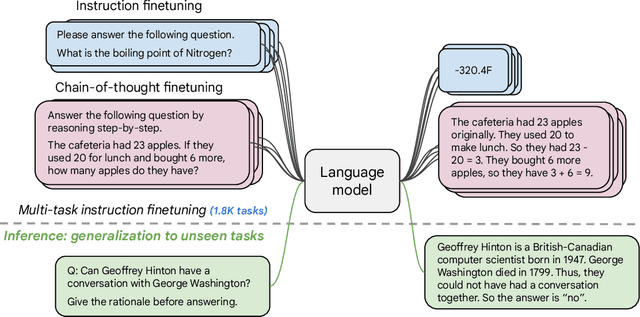
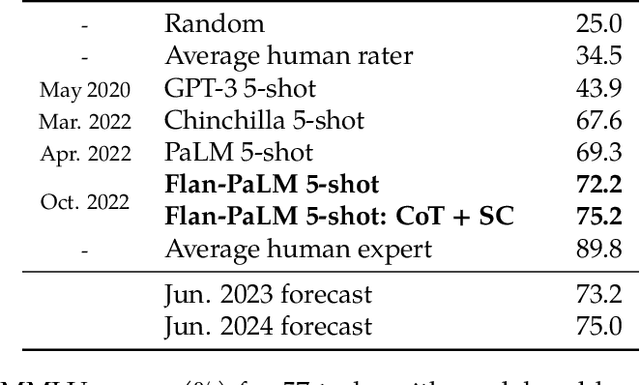
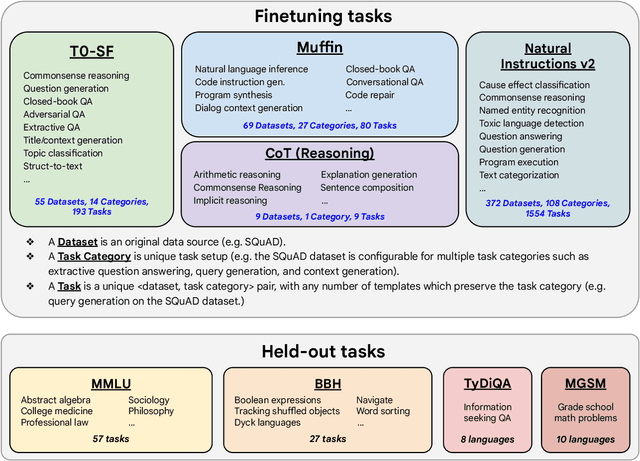
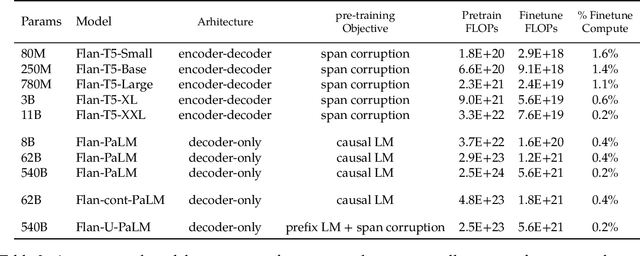
Abstract:Finetuning language models on a collection of datasets phrased as instructions has been shown to improve model performance and generalization to unseen tasks. In this paper we explore instruction finetuning with a particular focus on (1) scaling the number of tasks, (2) scaling the model size, and (3) finetuning on chain-of-thought data. We find that instruction finetuning with the above aspects dramatically improves performance on a variety of model classes (PaLM, T5, U-PaLM), prompting setups (zero-shot, few-shot, CoT), and evaluation benchmarks (MMLU, BBH, TyDiQA, MGSM, open-ended generation). For instance, Flan-PaLM 540B instruction-finetuned on 1.8K tasks outperforms PALM 540B by a large margin (+9.4% on average). Flan-PaLM 540B achieves state-of-the-art performance on several benchmarks, such as 75.2% on five-shot MMLU. We also publicly release Flan-T5 checkpoints, which achieve strong few-shot performance even compared to much larger models, such as PaLM 62B. Overall, instruction finetuning is a general method for improving the performance and usability of pretrained language models.
PaLM: Scaling Language Modeling with Pathways
Apr 19, 2022



Abstract:Large language models have been shown to achieve remarkable performance across a variety of natural language tasks using few-shot learning, which drastically reduces the number of task-specific training examples needed to adapt the model to a particular application. To further our understanding of the impact of scale on few-shot learning, we trained a 540-billion parameter, densely activated, Transformer language model, which we call Pathways Language Model PaLM. We trained PaLM on 6144 TPU v4 chips using Pathways, a new ML system which enables highly efficient training across multiple TPU Pods. We demonstrate continued benefits of scaling by achieving state-of-the-art few-shot learning results on hundreds of language understanding and generation benchmarks. On a number of these tasks, PaLM 540B achieves breakthrough performance, outperforming the finetuned state-of-the-art on a suite of multi-step reasoning tasks, and outperforming average human performance on the recently released BIG-bench benchmark. A significant number of BIG-bench tasks showed discontinuous improvements from model scale, meaning that performance steeply increased as we scaled to our largest model. PaLM also has strong capabilities in multilingual tasks and source code generation, which we demonstrate on a wide array of benchmarks. We additionally provide a comprehensive analysis on bias and toxicity, and study the extent of training data memorization with respect to model scale. Finally, we discuss the ethical considerations related to large language models and discuss potential mitigation strategies.
Zero-Shot Entity Linking by Reading Entity Descriptions
Jun 18, 2019



Abstract:We present the zero-shot entity linking task, where mentions must be linked to unseen entities without in-domain labeled data. The goal is to enable robust transfer to highly specialized domains, and so no metadata or alias tables are assumed. In this setting, entities are only identified by text descriptions, and models must rely strictly on language understanding to resolve the new entities. First, we show that strong reading comprehension models pre-trained on large unlabeled data can be used to generalize to unseen entities. Second, we propose a simple and effective adaptive pre-training strategy, which we term domain-adaptive pre-training (DAP), to address the domain shift problem associated with linking unseen entities in a new domain. We present experiments on a new dataset that we construct for this task and show that DAP improves over strong pre-training baselines, including BERT. The data and code are available at https://github.com/lajanugen/zeshel.
Synthetic QA Corpora Generation with Roundtrip Consistency
Jun 12, 2019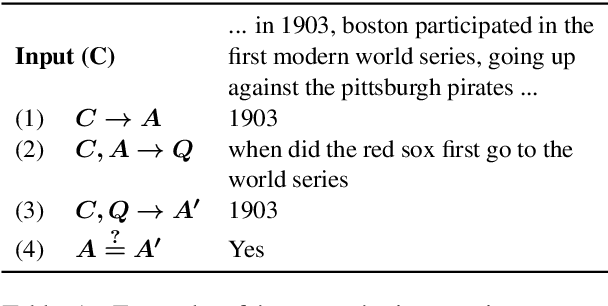
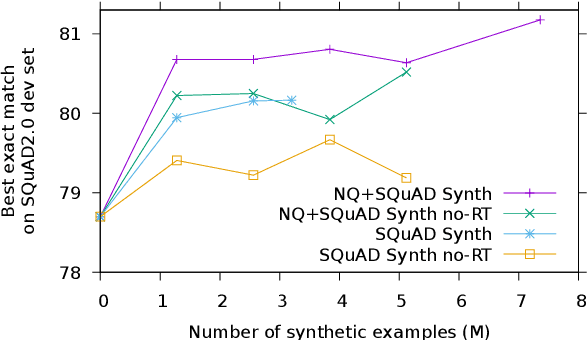
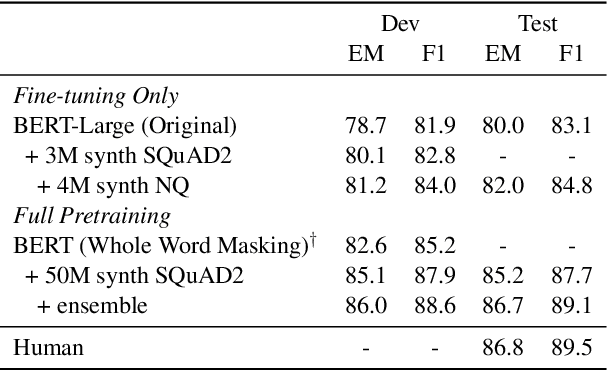

Abstract:We introduce a novel method of generating synthetic question answering corpora by combining models of question generation and answer extraction, and by filtering the results to ensure roundtrip consistency. By pretraining on the resulting corpora we obtain significant improvements on SQuAD2 and NQ, establishing a new state-of-the-art on the latter. Our synthetic data generation models, for both question generation and answer extraction, can be fully reproduced by finetuning a publicly available BERT model on the extractive subsets of SQuAD2 and NQ. We also describe a more powerful variant that does full sequence-to-sequence pretraining for question generation, obtaining exact match and F1 at less than 0.1% and 0.4% from human performance on SQuAD2.
Language Model Pre-training for Hierarchical Document Representations
Jan 26, 2019



Abstract:Hierarchical neural architectures are often used to capture long-distance dependencies and have been applied to many document-level tasks such as summarization, document segmentation, and sentiment analysis. However, effective usage of such a large context can be difficult to learn, especially in the case where there is limited labeled data available. Building on the recent success of language model pretraining methods for learning flat representations of text, we propose algorithms for pre-training hierarchical document representations from unlabeled data. Unlike prior work, which has focused on pre-training contextual token representations or context-independent {sentence/paragraph} representations, our hierarchical document representations include fixed-length sentence/paragraph representations which integrate contextual information from the entire documents. Experiments on document segmentation, document-level question answering, and extractive document summarization demonstrate the effectiveness of the proposed pre-training algorithms.
 Add to Chrome
Add to Chrome Add to Firefox
Add to Firefox Add to Edge
Add to Edge